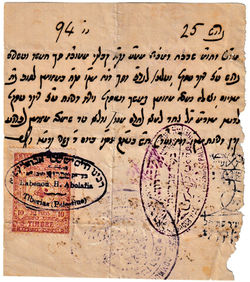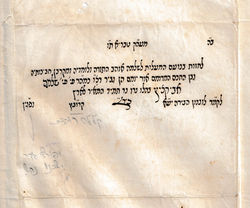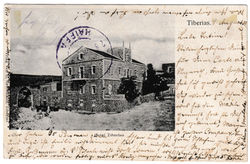top of page
TIBERIAS
Description
Tiberias. Also Teverya and Tabariyya. Founded in 20 CE and named for the Roman emperor, it eventually became the center of Holy Land Jewish life for most of a thousand years. This was the last home of the sitting Sanhedrin. It is where the system of vocalizing Hebrew texts used today was developed. Significant portions of the Mishna and Jerusalem Talmud were also developed here. Teverya was subject to the whims of Romans, Byzantines, Arabs, Crusaders and Ottomans, and also suffered several earthquakes. Sephardic Jews were invited in the 1500s, and Polish Jews around 1800. It had regained a Jewish majority by 1900. Tiberias' main features are the lake, hot springs, tombs of Talmudic sages, and famously the tomb of Rabbi Meir 'Baal Haneis'.
 General ViewTiberias' original appeal was its location on the shore of Lake Tiberias, as shown here. |  2 Views - Painting and PhotoThe top view is an idealized painting. Below is an early 20th century photographic image of the town. |  Distant ViewThis image identifies nearby locations which are mentioned in the New Testament. They are ancient locations which later took on Christian connections. |
|---|---|---|
 Panorama ViewThis postcard unfolds to a triple-width picture of old Tiberias, with the mosque featured in the center. |  Kollel Note.Tamuz 1916The Kollel system operated in Tiberias too, helping to support scholars and needy families. This note is an I.O.U. for 1 (Turkish) Mejidi, to be paid 'when there is money in our treasury'. Dated 1916 and bearing the seal of R' Haim Aboulafia (1884-1970), chief rabbi of the city from 1911-1918. He was a Sefardic community leader, activist, and Zionist from an illustrious family. |  Kollel note.Tishrei 1916This note in Soletreo is a receipt for 25 Grush, dated Tishrei 5676 (=1916). In addition to R' Aboulafia's seal, 4 other seals have been stamped on it, hard to read. |
 Rabbinic Court Letter.1928As the letterhead and seal attest, this is a letter from the Sephardic rabbinic Court, dated Adar 1928. the writing is 'Rashi' style, common among Sepharadim. it is addressed to the rabbinic office in Haifa. A couple is at odds and the husband is offering inadequate support for his wife and child. 'Please try for reconciliation or at least arrange appropriate support. Signers include R' Meir Vaknin and R' Yaakov Zreyhan. |  Yeshiva OR TORAH.1905This envelope reflecting the Ashkenazic community was sent by Yeshiva Ohr Torah to Bretten Germany in 1905. Doubtless it contained a plea for donations. The yeshiva had been founded in 1900 by Slonimer Chassidim and was built in the Rabbi-Meir-Baal-Haness complex, next to older Sephardic buildings. The envelope went through the Ottoman mail system. |  Tal Torah School.1921Rabbi Refael Bibas (1860-1953) came from a prominent Sephardic Rabbinic family in Morocco. He arrived in Tiberias in 1902. This envelope, sent to New York City in 1921, was also a plea for funds, to support the Yeshiva and orphan education. |
 Jacob Moses ToledanoAmong the scholars of Tiberias was R' Jacob Moses Toledano (1880-1960). He was interested in Mizrachi ('oriental') Jewry and corresponded with European scholars regarding ancient manuscripts about them. In1904 he wrote to R' Ehrentreu in Munich asking for the contents of manuscripts about Jews in Morocco and Libya. |  Rabbi Meir VakninPostcard sent from Tunis to Tiberias in 1910, written in Soletreo. The addressee, R' Meir Vaknin (1885-1975) was a highly respected Rabbi/scholar in Tiberias. Head of the Sephardic community, he was the chief rabbi of the city. He also founded the Yeshiva Meir Bas Ayin. business and family matters are discussed. |  Book.Kalah Rabati.TitleThis slim volume was published in Tiberias in 1906. The text is the 1st chapter of 'Masechet Kallah Rabati'. R' Baruch Toledano (1883 - 1969), scholar & leader in the community, published it with a commentary based on a manuscript in Morocco. He was a researcher of Judeo-Arabic literature, and head of the Rabbinic Court in Yaffo. |
 Masechet Kallah Rabati textThe book is a compendium of guidance from the Gaonic period regarding marital life. This opening page quotes a reference from Talmud that a genuine scholar is someone who knows even the material later recorded in this work. The preface also includes some history of the commentary's author - R' Avraham ben R' Natan Hayarchi. |  Letter to Modena JewsThe Hebrew inscription begins with "From the Holy City of Tiberias". Since it is stamped and postmarked in Livorno, Italy, it must have been carried there by hand & then put in the mail.The back stamp reading 'Universita Israelitica di Livorno' is the seal of the Jewish Community Council. Addressed to the Jews of Modena, it refers to 'treasurers, scholars, supporters, contributors, officers etc. etc' & no doubt asked for funds. The Modena community were long-time supporters of the Holy Land. |  Shador Letter to Morocco.1845This extremely flowery 'Emissary Letter' was sent to Morocco in 1845, asking for support for the scholars of the community who spend their days and nights in Torah study. The need is especially great in light of droughts and locusts. Signed by ELEVEN community rabbis/leaders with their elaborate Sephardic signatures. 4 are Aboulafias, also Simchon, Abadi, Malka, Gigi and Maman last names. The seal, presumably from the rabbinic council, is indistinct. |
 Shador to Morocco.AddresseeThe cover page states that this letter comes from Tiberias and is addressed to (with many honorifics) Shlomo Abikatzitz, a leader and supporter of Torah institutions. [At the end are initials which reserve curses for any who infringe on this effort.] |  Shador Card with MessageR' Eliyahu Adahan reached Tiberias from Morocco in 1875. Years later he he became a Shador (emissary) to gather funds for the community. This was his visiting card which he used also as a note to make his request. "To....R' Shlomo Even Tzur...I am about to send the donations to the Holy Land this week and respectfully request that you send me your donations....May G-d grant you (etc.).... . Head of Court & Shador, Purebred Sepharadi". This was in Morocco in about 1910. |  Donation Receipt.1909.SepharadimDated 1909, this is a receipt for a donation of 35 Francs from one Rafael Hazarfati. It was apparently given for the recovery of R' Aharon Alhadif, who did pass away. Signed by 4 community rabbi/leaders including R' Mahluf Hakohen and R' David Raina. And stamped with the seals of the Sephardic council and the Yeshiva at the R' Meir Baal Haness tombsite. |
 Receipt.1912 IzmirThis ornamental receipt was issued by the Kollels of Tiberias. It is for the amount of 17.2 Turkish Kurush and is dated 1912. The donor was Ben Zion Habif of Izmir (Smyrna Turkey). There are 4 Sephardic signatures and seals. They include Rabbis Yaakov Kohen Skilly, Shlomo Yitzchak Sithon, and Makhlouf Hakohen. Printed in gold ink. Above is a drawing of the synagogue & Beit Midrash at the Meir Baal Haneiss tomb. |  Ben Danan.1925.Judeo ArabicDated 1925, this letter is written in Judeo-Arabic, with some Hebrew phrases. It appears to be a plea for funds to support the institutions of Tiberias and is written on stationery of the Torah school there. The writer and signer is R' Shmuel ibn Danan, in Fez, Morocco (1874 - 1962). A highly respected scholar in Morocco, he was treasurer for numerous Torah institutions in the Holy Land. |  Bibas.1925.Shador.DenanOn the same stationery, this is R' Bibas himself, introducing R' Danan as an emissary for the Torah institutions of Tiberias. Addressed to Sr. Shelomo d'Yosef it refers to the past world war, and high prices, which threaten the existence of the community. R' Shmuel ibn Danan will explain in detail, and accept donations. signed by R' Bibas. Seals of the Talmud Torah, Yeshiva, and Orphanage. 1925. |
 Bibas to IIbn Danan.1921R' Bibas writes directly to R' Ibn Danan informing him that he will receive letters addressed to various persons in his community, asking for support for Teverya institutions. Would he please distribute them so that when the emissary comes to collect funds they will respond. And please ask Sr. Azarof why thank- you letters have not yet been distributed. Best wishes for the coming Passover holiday. Signed and sealed. |  Funds Flyer.LocustsThis printed flyer was sent abroad from Tiberias as a plea for donations to the people and institutions of the city. From the folds it is clear that it was sent in the mail in one of those ubiquitous colored donation envelopes. We can date it by the mention of a heavy plague of locusts that is referred to, which stripped the land of vegetation in 1915, making sustenance even harder. And of course this was during World War One. |  Funds Flyer.Locusts.topAt the top, next to the city name Teveriya, we read in Hebrew and German the name of the welfare organization: Ozer Dalim. 'For the benefit of our fellow Jews, the poor, forlorn, widows, orphans, childbearing, and sick'. ...terrible poverty, lack of business, sickness, locusts ....and Torah scholars... .and when we heard that the kind sir was caring and generous...'. |
 Funds Flyer.Locusts.bottomAt the bottom we see a now familiar image of the R' M.B.Haneis tomb, and also the Dome of the Rock in Jerusalem. Names and addresses of the administrators of the fund are given, for sending donations to Tiberias, Turkey. |  Locusts.Before and AfterThese two images from the locust plague illustrate the effect of the locusts on local vegetation. |  Chalukah Recipients.1923Dated October 1923, this is a list of distributions of chalukah funds to scholars studying at Yeshivat Eitz Haim of Sepharadim. Some recipients stamped their seal next to their name. Most if not all are names of Moroccan origin: Abulafia, Adahan, Malka, Kubi, Shetrit. Below: 'We the scholars of Yeshivat Eitz Haim each received 80 grush allotment for Oct 15 - Nov 15, through Jerusalem, from the council in New York. |
 Tiberias.Receipt.blank |  Receipt.1923.SephardicReceipt for 50 Egyptian 'grush' dated 1923, issued by the general Sephardic council for their welfare fund. Colorful and stamped by 7 rabbis and officials: Judah Toledano, Refael Iluz, Yakov Vaknin, Eliyahu Ilus, Yakov Zrehen, Sephardic council, Meir Baal Haneis synagogue. |  'Rabbi Meir Baal Haneis'Rabbi Meir was a Talmudic master mentioned repeatedly in the Mishna. Legends associated with him claim he promised to intercede on behalf of Jews in need whenever they donate to the poor and cry out 'Oh G-d of R' Meir answer me'. He is buried on the shore of Lake Tiberias, where yeshivot and synagogues have been built. The charity documents shown here all mention him and the fund in his name. |
 Personal PC.MoraviaThis personal Postcard was sent from Tiberias to Moravia (today Czechoslovakia) in 1897. R' Motel Aschkenasi writes R' Dr. Placzek with flowery honorifics and blessings, asking for his generosity in helping the writer to make a wedding for his grandson. He closes with his personal seal and his address, written in Latin alphabet, for convenience. Individuals made their personal appeals for help from generous persons they identified abroad. |  Personal PC.CopenhagenR' David Schiffman writes a personal postcard to Grand Rabbi D. Simonsen in Denmark in 1897 with a personal plea for help. He has stuck his neck out to borrow some 50 gold Napoleans to pay for his daughter's recent wedding. Although it was pointless to invite him to the wedding overseas, he implores him to help with loan repayment. Many blessings for his help. Signed in Hebrew and in Latin script for convenience. |  Funds for Wedding.1961Moshe Zinger sent this letter to the Ezras Torah organization in 1961, requesting help in making a wedding for his son Mordechai. He is still suffering under the burden of the previous family wedding 3 years previous. The letter is endorsed by R' Avraham Auerbach of the city's chief rabbinate. He knows the fine young man and his bride and they are very deserving of help. |
 Toledano to Palagi letterR' Baruch Toledano writes to R' Palagi in Tzefat, in 1935. He is writing on stationery of the Sephardic Kollel. In regard to money he has sent, he wants to make it clear that the donor's intention was that his donation would specifically go to needy Jews from Damascus. He asks that a record be kept. The script is Solotreo. |  Toledano Letter.backOn the back of the letter, R' Moshe Yeshua Palagi has imprinted his stamp. Following directions, he has written down who received funds, and how much they got. in Arabic numerals and Solotreo we see the list. It includes names such as: Peretz, Kadour, Damesek, Toviano, Zaid. |  Business Letter.1933Aron Judah Kubi writes a business letter on his company stationery in 1933. Some Tiberias residents did conventional work for a living. |
 Ladino postcardRodoph Lefcovitz from Jerusalem is writing to cousin Moshe in Tiberias. It's 1943 and he is asking about getting in touch with 'Salvator'. Interestingly, the message is written in Ladino, in Latin letters. |  Rabbi Meir Baal HaneisThe number one attraction in Teverya for Jews is the tomb of Rabbi Meir Baal Haneis (miracle worker) shown here on the lake shore. Rabbi Meir was a Talmudic master mentioned repeatedly in the Mishna. Legends associated with him claim he promised to intercede on behalf of Jews in need whenever they donate to the poor and cry out 'Oh G-d of R' Meir answer me'. The charity funds all bear his name. |  Hot springsJust south of the city are the famous Hot Springs. these were already popular in antiquity. They remain a tourist attraction today accompanied by hotels and restaurants. |
 Sea of KinneretTiberias' most obvious and popular feature has been the Lake/Sea. It has been called variously Sea of Galilee, Lake Tiberias, Sea of Kinneret, Lake/Sea of Ginosar. It has historical connections and fishing grounds. Until desalinization, it was Israel''s primary source of fresh water. Still a prime tourist location today. |  Tomb of RambamMaimonides/Rambam is buried here and his tomb is a major pilgrimage destination. Tombs of other sages are in the area: Rabbi Akiva, R' Yochanan ben Zakkai, R' Eliezer ben Hyrcanus, R' Yehoshua ben Chanania, etc. Also famous women: Bilhah and Zilpah (wives of Jacob) Yocheved and Zipporah (mother and wife of Moses), etc. |  Jewish SitesThis postcard uses the popular heading "Greetings From (in this case) Tiberias". Clearly intended for a Jewish audience, the card pictures 3 special sites: the tomb of the Rambam, the tomb of R' Yochanan b. Zakkai, and the tomb of R' Meir Baal Haneis. Actually mailed 21 January 1899 in Berlin - which is also where it was printed. |
 Tiberias HotelThere is no shortage of hotels in Tiberias today but the one pictured here was perhaps the first. This postcard was sent to Haifa from Tiberias in 1909, to a German Colony resident. |  Tiberias.MosqueThis is the Al Amari mosque of Tiberias, built in 1743. It was the most prominent building in the city for many years. It is largely unused since 1948. |  Recent EnvelopesOver a hundred years later, appeals for support of the R' Meir Baal Haneis Fund continue. These colorful envelopes use vintage and contemporary views of the tomb complex outside, while making their appeals for the poor and hungry inside. |
bottom of page